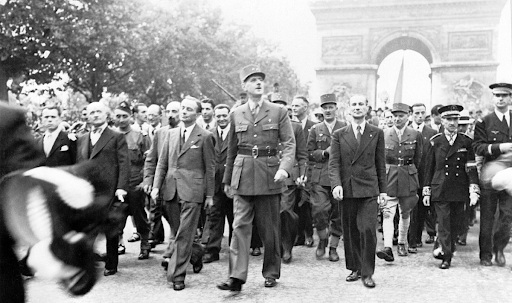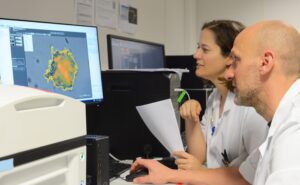The Battle for the City of Light
The Liberation of Paris, occurring from August 19 to August 25, 1944, was a pivotal moment in World War II. For months after the D-Day operations began earlier in the summer on June 6th, a ferocious resistance fight led by allied troops pushed deeper inland from the coast. By then, Paris had been under Nazi occupation for over four years. The French capital, which had stood for progress, enlightenment, and liberation for centuries, was shrouded in surveillance and oppression under the thumb of the Nazi regime and the Vichy government.
The battle officially started on August 19, 1944, when the French Forces of the Interior (FFI) and the Parisian police initiated an uprising against the German garrison in Paris. Inspired by the advancing Allied forces and eager to liberate their city, the resistance fighters began to seize strategic points throughout Paris, such as police stations, government buildings, and transportation hubs. The uprising was a spontaneous and widespread effort, marked by intense street fighting and skirmishes.
© Paris Musées
During the occupation, a network of resistance operatives was working (literally) underground to gather information and smuggle it to the Free French troops and allies. Underneath the stately 18th century pavilion where the museum stands today, Colonel Rol and his wife Cécile established a base in the structure’s former air raid bunker, which was home to a private, undetectable phone line network. This bunker became the command center for the entire week-long battle.
As the résistants coordinated from inside the city, American and Allied troops played a crucial role in liberating the French capital from Nazi occupation. On August 24, elements of the 4th Infantry Division of the U.S. Army, under General Raymond O. Barton, and the 2nd French Armored Division, under General Philippe Leclerc, entered the outskirts of Paris. The next day, on August 25, they advanced into the city, with American tanks rolling through the streets and engaging in firefights with the remaining German forces.
General Charles de Gaulle, leading the Free French Forces, entered Paris triumphantly on August 25, 1944. He delivered his famous speech at the Hôtel de Ville, declaring the liberation of Paris and asserting French sovereignty. The sight of the French Tricolor flying over the city and the crowds cheering for de Gaulle and the liberating forces marked a triumphant return to freedom and democracy.
The Legacy of the Musée de la Libération de Paris
Established in 1994, the Musée de la Libération de Paris – Musée Général Leclerc – Musée Jean Moulin (known simply as Musée de la Libération) is dedicated to Général Leclerc and Jean Moulin, two iconic figures of the French Resistance.
General Philippe Leclerc de Hauteclocque was instrumental in the liberation of Paris during World War II. As the commander of the French 2nd Armored Division, he led his troops with courage and strategic prowess. Under his leadership, the division advanced through France, playing a crucial role in the final push against German forces. Leclerc’s decisive actions and military expertise were pivotal in the liberation of the French capital from Nazi occupation, marking a significant moment in both the war and French history.
© Paris Musées
Jean Moulin was a highly respected civil servant before the war. After the fall of France, he refused to collaborate with the Vichy regime and joined the Resistance. Moulin was tasked by General de Gaulle to unify the resistance groups under one cohesive organization. He traveled across occupied France, risking his life to meet with resistance leaders and sabotage the Nazi regime. In June 1943, he was betrayed and arrested and subsequently tortured at the hands of Klaus Barbie, the infamous “Butcher of Lyon.” Moulin, never revealing any information, died from his injuries on July 8, 1943.
The museum, named in their honor, serves as a tribute to their leadership and sacrifice, and to the collective effort of the French and Allied forces. It attracts thousands of visitors annually, offering an experience that combines personal testimonies, innovative immersive exhibits, and thousands of historical artifacts. The museum’s chief mission is to educate future generations about these defining moments of the past.
“Fewer and fewer of the generation who were directly involved can now pass on their story,” said Sylvie Zaidman, the museum’s director, for The Guardian in 2019 on the occasion of the museum’s move to the historic villa where it now stands. “This is about helping today’s public to understand and reflect on a fundamental page of France’s history… It’s now our responsibility to make sure everyone understands that it’s our history, too.”
Current Exhibitions: Celebrating French-American Relations
The Musée de la Libération de Paris features several exhibitions, some of which emphasize the strong ties between France and the United States, reflecting on their collaborative efforts during World War II.
“Paris brûle-t-il? Quand le cinéma réinvente la Libération” Is Paris Burning? When cinema reinvents the Liberation.
Running until September 22, this exhibition explores the cinematic portrayal of the Liberation of Paris in the classic film “Paris brûle-t-il?” Featuring stars like Alain Delon, Jean-Paul Belmondo, Yves Montand, and American actors Kirk Douglas and Orson Welles, this film remains a significant cultural reference. The exhibition invites visitors to question historical representations and the line between history and interpretation. This exhibit, recognized with the Mission Libération de l’État label, underscores the enduring cultural connections between France and the United States.
“Champions de la Liberté. Portraits de sportifs résistants et français libres” Champions of Liberty: Portraits of Athlete Resistors and Free French Fighters
Until August 18, this exhibition showcases the biographies of renowned athletes who joined the Resistance. These figures, once champions in sports like tennis, fencing, and football, chose to fight for freedom. Highlighting the stories of individuals like Auguste Delaune and Georges Tainturier, the exhibition reveals the personal sacrifices made during the war. The free entry ensures accessibility, allowing many to engage with these inspiring stories.
“Clap! sur la Libération de Paris” Action! The Liberation of Paris
From August 20 to September 20, visitors can view archival footage of the Liberation, captured by amateur filmmakers. These historical films, presented in partnership with the association Mémoires filmiques d’Île-de-France – Cineam, offer a unique, personal perspective on the events of 1944. The free and continuous screenings provide an immersive historical experience.
Immersive Visit Experience
The museum offers a mixed reality experience that places visitors in the role of a resistant journalist during the Liberation. Set 20 meters below the museum in the former command center during the liberation of Paris, this interactive journey through a command post provides a unique, hands-on understanding of the period. This innovative tour is free, with three sessions daily.
Supporting the Musée de la Libération de Paris
Friends of Fondation de France proudly supports the Musée de la Libération de Paris by facilitating tax-deductible donations from American donors to Paris Musées, the organization overseeing 14 iconic Paris museums. By supporting the museum, you help preserve the memory of the brave French and Allied freedom fighters and promote French-American friendship.
To learn more about the Musée de la Libération de Paris and how you can contribute to their vital work, please visit the Paris Musées page on our website. Your generosity ensures that the legacy of liberation and the stories of courage and cooperation continue to inspire future generations.



